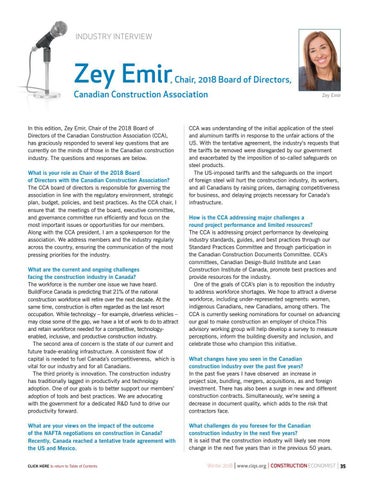INDUSTRY INTERVIEW
Zey Emir
, Chair, 2018 Board of Directors,
Canadian Construction Association
In this edition, Zey Emir, Chair of the 2018 Board of Directors of the Canadian Construction Association (CCA), has graciously responded to several key questions that are currently on the minds of those in the Canadian construction industry. The questions and responses are below. What is your role as Chair of the 2018 Board of Directors with the Canadian Construction Association? The CCA board of directors is responsible for governing the association in line with the regulatory environment, strategic plan, budget, policies, and best practices. As the CCA chair, I ensure that the meetings of the board, executive committee, and governance committee run efficiently and focus on the most important issues or opportunities for our members. Along with the CCA president, I am a spokesperson for the association. We address members and the industry regularly across the country, ensuring the communication of the most pressing priorities for the industry. What are the current and ongoing challenges facing the construction industry in Canada? The workforce is the number one issue we have heard. BuildForce Canada is predicting that 21% of the national construction workforce will retire over the next decade. At the same time, construction is often regarded as the last resort occupation. While technology – for example, driverless vehicles – may close some of the gap, we have a lot of work to do to attract and retain workforce needed for a competitive, technologyenabled, inclusive, and productive construction industry. The second area of concern is the state of our current and future trade-enabling infrastructure. A consistent flow of capital is needed to fuel Canada’s competitiveness, which is vital for our industry and for all Canadians. The third priority is innovation. The construction industry has traditionally lagged in productivity and technology adoption. One of our goals is to better support our members’ adoption of tools and best practices. We are advocating with the government for a dedicated R&D fund to drive our productivity forward. What are your views on the impact of the outcome of the NAFTA negotiations on construction in Canada? Recently, Canada reached a tentative trade agreement with the US and Mexico. CLICK HERE to return to Table of Contents
Zey Emir
CCA was understanding of the initial application of the steel and aluminum tariffs in response to the unfair actions of the US. With the tentative agreement, the industry’s requests that the tariffs be removed were disregarded by our government and exacerbated by the imposition of so-called safeguards on steel products. The US-imposed tariffs and the safeguards on the import of foreign steel will hurt the construction industry, its workers, and all Canadians by raising prices, damaging competitiveness for business, and delaying projects necessary for Canada’s infrastructure. How is the CCA addressing major challenges a round project performance and limited resources? The CCA is addressing project performance by developing industry standards, guides, and best practices through our Standard Practices Committee and through participation in the Canadian Construction Documents Committee. CCA’s committees, Canadian Design-Build Institute and Lean Construction Institute of Canada, promote best practices and provide resources for the industry. One of the goals of CCA’s plan is to reposition the industry to address workforce shortages. We hope to attract a diverse workforce, including under-represented segments: women, indigenous Canadians, new Canadians, among others. The CCA is currently seeking nominations for counsel on advancing our goal to make construction an employer of choice.This advisory working group will help develop a survey to measure perceptions, inform the building diversity and inclusion, and celebrate those who champion this initiative. What changes have you seen in the Canadian construction industry over the past five years? In the past five years I have observed an increase in project size, bundling, mergers, acquisitions, as and foreign investment. There has also been a surge in new and different construction contracts. Simultaneously, we’re seeing a decrease in document quality, which adds to the risk that contractors face. What challenges do you foresee for the Canadian construction industry in the next five years? It is said that the construction industry will likely see more change in the next five years than in the previous 50 years. Winter 2018 | www.ciqs.org | CONSTRUCTION ECONOMIST | 35






